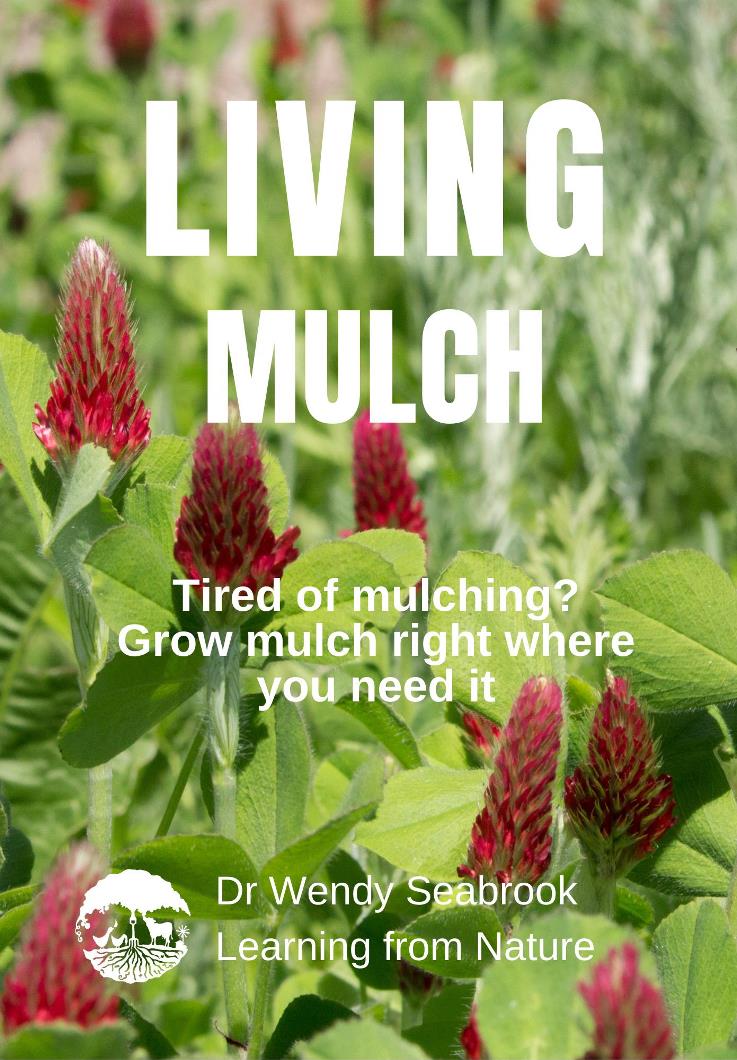Nobody would dispute the value of mulch. But instead of bringing mulch in from somewhere else at cost, we’re better off growing living mulch right where we need it!

Before and After – From Mulch to Living Mulch
Growing living mulch, we create a permanent living ground cover using a mixture of perennial and self-seeding ground cover plants. Living mulch is cheaper and less back-breaking than spreading mulch! It reduces weed issues by producing a thick ground cover of living plants and mulch from the dead leaves and stems. It’s generally less fire-prone than dry mulch, particularly when using fire-retardant plants.
Growing living mulch is Eco-logical! Here’s why –
Eco-Logic of Growing Living Mulch
Take a look at the native vegetation in your region. In these natural areas, no one needs to spread mulch. Mulch gets produced right where needed, sourced from living ground covers or trees and shrubs growing above. Compared to our sporadic mulch applications, living mulch provides a more consistent and generous food supply of organic materials for the soil organisms, maintaining our soil infrastructure and nutrient recycling system.
Ground cover plants also supply roots and root exudates, enabling more organic matter to be stored in our soil. Root exudates are the sugars and proteins plants release from their roots to feed fungi and bacteria in our soil. Plants allocate 20-60% of the solar energy they capture to produce these exudates.
Only a small portion of the organic materials from above-ground inputs like leaf litter, mulch, crop stubble, and compost are stored long-term as organic matter in our soil. That’s why mulch has the annoying habit of quickly disappearing!
Tips to help you Grow Living Mulch
- Grow mixtures of perennials and self-seeding annual and bi-annual plants to create low-maintenance permanent ground covers.
- Use species that thrive in your growing conditions to grow from your strengths.
- Use plant species producing a thick ground cover of leaves and mulch to reduce the growth of undesirable plants.
- Create habitat diversity by choosing plants with different growth forms (leaves, shoots and roots) – it’s a simple way to build connections and increase biodiversity (see Eco-logical Farming or Gardening Handbook for details).
- Get free ecological services using ecological support plants in your living mulch species mix.
- Using clumping and mat-forming species works well, but running plants spread across the ground and root in new spots reduces establishment costs.
- Grow taller and climbing plants if you have time to cut and drop, as they generally grow more plant biomass for mulch.
Remember that not all weeds are bad! Weeds are usually indicators of degraded soil. Weeds can grow in these conditions because they are the experts at regenerating soil. Given a chance, they will enthusiastically help us improve our soil.
So next time you’re working hard spreading dead plant material, think instead about growing living mulch and discover the fail-safe techniques in our handbook for farmers and gardeners – Living Mulch.
 The handbook takes you through a series of straightforward, tried and tested steps to prepare your site and select species producing a dense ground cover. The handbook is 100% focused on helping you achieve practical outcomes – saving you the time and trouble of finding your own way.
The handbook takes you through a series of straightforward, tried and tested steps to prepare your site and select species producing a dense ground cover. The handbook is 100% focused on helping you achieve practical outcomes – saving you the time and trouble of finding your own way.
Feature image by Simon Berger
